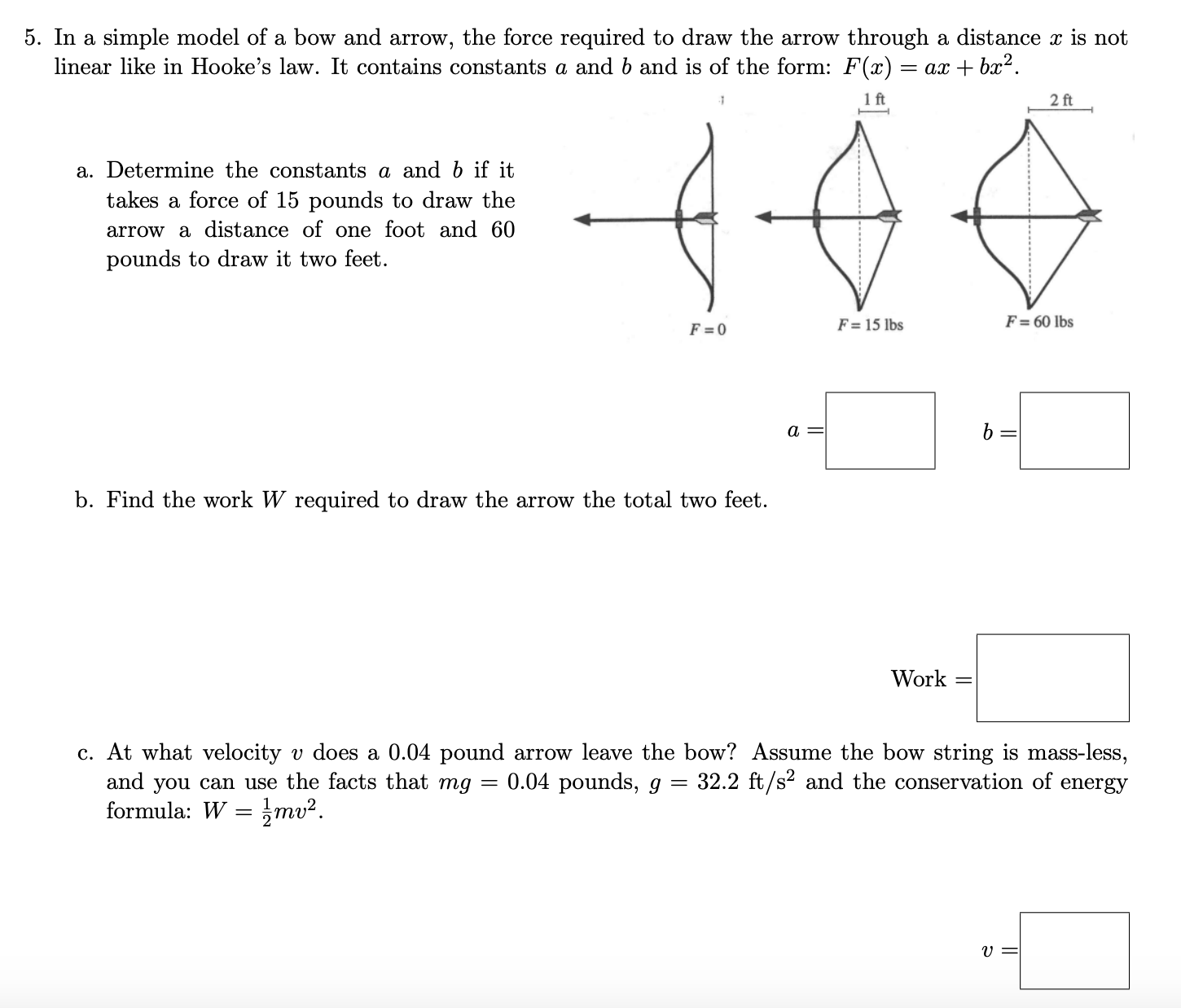5. In a simple model of a bow and arrow, the force required to draw the arrow through a distance x is not linear like in Hooke's law. It contains constants a and b and is of the form: F(x) = ax + bx². 1 ft 2 ft a. Determine the constants a and b if it takes a force of 15 pounds to draw the arrow a distance of one foot and 60 pounds to draw it two feet. F = 0 F = 15 lbs F = 60 lbs a b. Find the work W required to draw the arrow the total two feet. Work = c. At what velocity v does a 0.04 pound arrow leave the bow? Assume the bow string is mass-less, and you can use the facts that mg formula: W 0.04 pounds, g = 32.2 ft/s and the conservation of energy mv². U 3=
5. In a simple model of a bow and arrow, the force required to draw the arrow through a distance x is not linear like in Hooke's law. It contains constants a and b and is of the form: F(x) = ax + bx². 1 ft 2 ft a. Determine the constants a and b if it takes a force of 15 pounds to draw the arrow a distance of one foot and 60 pounds to draw it two feet. F = 0 F = 15 lbs F = 60 lbs a b. Find the work W required to draw the arrow the total two feet. Work = c. At what velocity v does a 0.04 pound arrow leave the bow? Assume the bow string is mass-less, and you can use the facts that mg formula: W 0.04 pounds, g = 32.2 ft/s and the conservation of energy mv². U 3=
Physics for Scientists and Engineers, Technology Update (No access codes included)
9th Edition
ISBN:9781305116399
Author:Raymond A. Serway, John W. Jewett
Publisher:Raymond A. Serway, John W. Jewett
Chapter5: The Laws Of Motion
Section: Chapter Questions
Problem 5.53P: Review. A rifle bullet with a mass of 12.0 g traveling toward the right at 260 m/s strikes a large...
Related questions
Question
letter c

Transcribed Image Text:5. In a simple model of a bow and arrow, the force required to draw the arrow through a distance x is not
linear like in Hooke's law. It contains constants a and b and is of the form: F(x) = ax + bx².
1 ft
2 ft
a. Determine the constants a and b if it
takes a force of 15 pounds to draw the
arrow a distance of one foot and 60
pounds to draw it two feet.
F = 0
F = 15 lbs
F = 60 lbs
a
b. Find the work W required to draw the arrow the total two feet.
Work =
c. At what velocity v does a 0.04 pound arrow leave the bow? Assume the bow string is mass-less,
and you can use the facts that mg
formula: W
0.04 pounds, g = 32.2 ft/s and the conservation of
energy
mv².
U 3=
Expert Solution
This question has been solved!
Explore an expertly crafted, step-by-step solution for a thorough understanding of key concepts.
This is a popular solution!
Trending now
This is a popular solution!
Step by step
Solved in 6 steps with 8 images

Knowledge Booster
Learn more about
Need a deep-dive on the concept behind this application? Look no further. Learn more about this topic, physics and related others by exploring similar questions and additional content below.Recommended textbooks for you

Physics for Scientists and Engineers, Technology …
Physics
ISBN:
9781305116399
Author:
Raymond A. Serway, John W. Jewett
Publisher:
Cengage Learning

Principles of Physics: A Calculus-Based Text
Physics
ISBN:
9781133104261
Author:
Raymond A. Serway, John W. Jewett
Publisher:
Cengage Learning

Physics for Scientists and Engineers: Foundations…
Physics
ISBN:
9781133939146
Author:
Katz, Debora M.
Publisher:
Cengage Learning

Physics for Scientists and Engineers, Technology …
Physics
ISBN:
9781305116399
Author:
Raymond A. Serway, John W. Jewett
Publisher:
Cengage Learning

Principles of Physics: A Calculus-Based Text
Physics
ISBN:
9781133104261
Author:
Raymond A. Serway, John W. Jewett
Publisher:
Cengage Learning

Physics for Scientists and Engineers: Foundations…
Physics
ISBN:
9781133939146
Author:
Katz, Debora M.
Publisher:
Cengage Learning

College Physics
Physics
ISBN:
9781285737027
Author:
Raymond A. Serway, Chris Vuille
Publisher:
Cengage Learning

Physics for Scientists and Engineers with Modern …
Physics
ISBN:
9781337553292
Author:
Raymond A. Serway, John W. Jewett
Publisher:
Cengage Learning

Physics for Scientists and Engineers
Physics
ISBN:
9781337553278
Author:
Raymond A. Serway, John W. Jewett
Publisher:
Cengage Learning